Organizational Behavior: Attitudes, Commitment, and Job Satisfaction
VerifiedAdded on 2020/04/01
|7
|1915
|76
Essay
AI Summary
This essay delves into the realm of organizational behavior, examining the crucial interplay between attitudes and behaviors within the workplace. It highlights how individual attitudes, shaped by various factors like personal experiences and upbringing, significantly influence employee conduct and performance. The essay further explores the importance of attitudes in navigating workplace challenges and achieving job satisfaction, emphasizing the role of positive attitudes in fostering commitment and productivity. It identifies key factors that contribute to job satisfaction, such as educational level and skill alignment, while also discussing the concept of organizational commitment and how managers can assess employee dedication through performance evaluations and observable behaviors like communication skills and initiative. The essay underscores the significance of maintaining a positive attitude to overcome obstacles and achieve success in the professional setting.
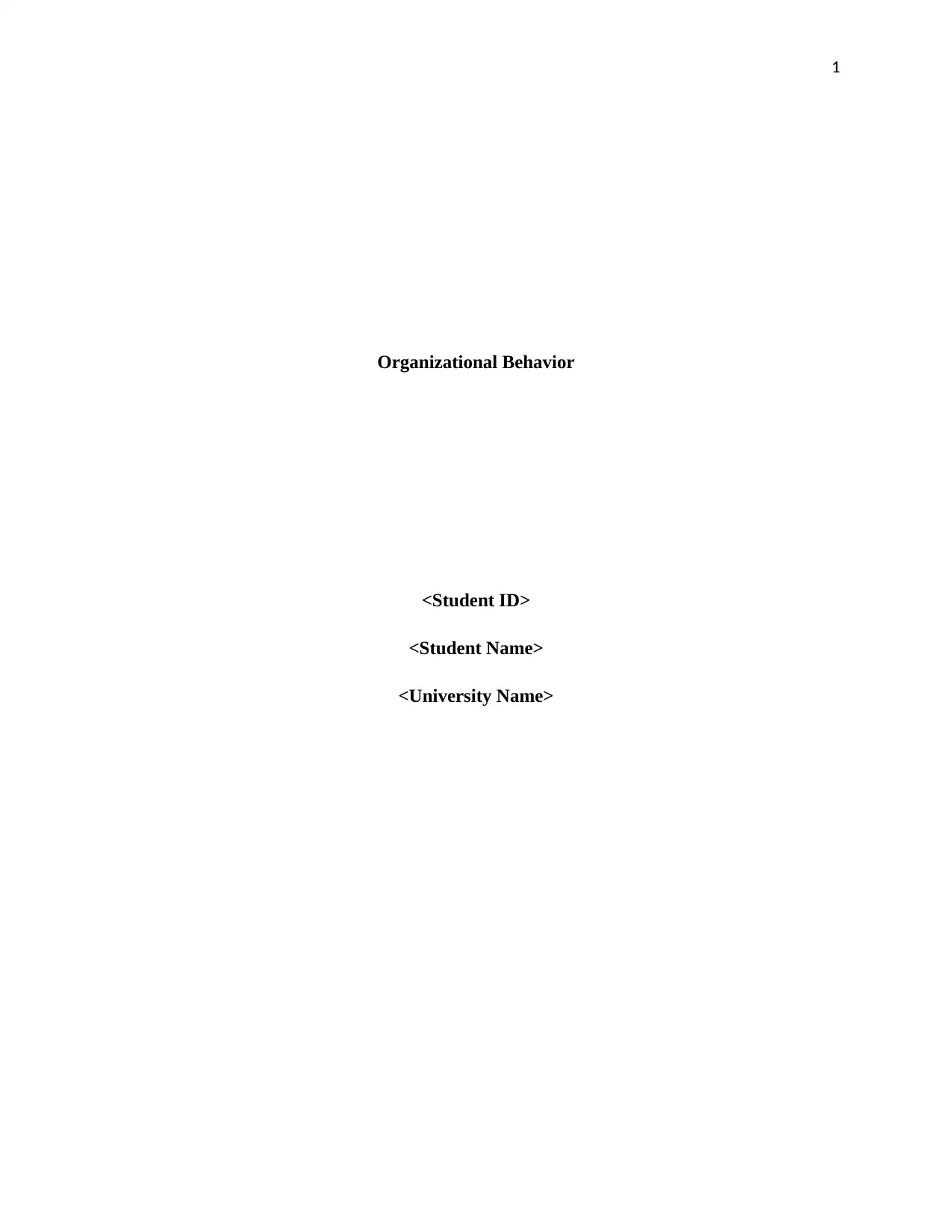
1
Organizational Behavior
<Student ID>
<Student Name>
<University Name>
Organizational Behavior
<Student ID>
<Student Name>
<University Name>
Paraphrase This Document
Need a fresh take? Get an instant paraphrase of this document with our AI Paraphraser
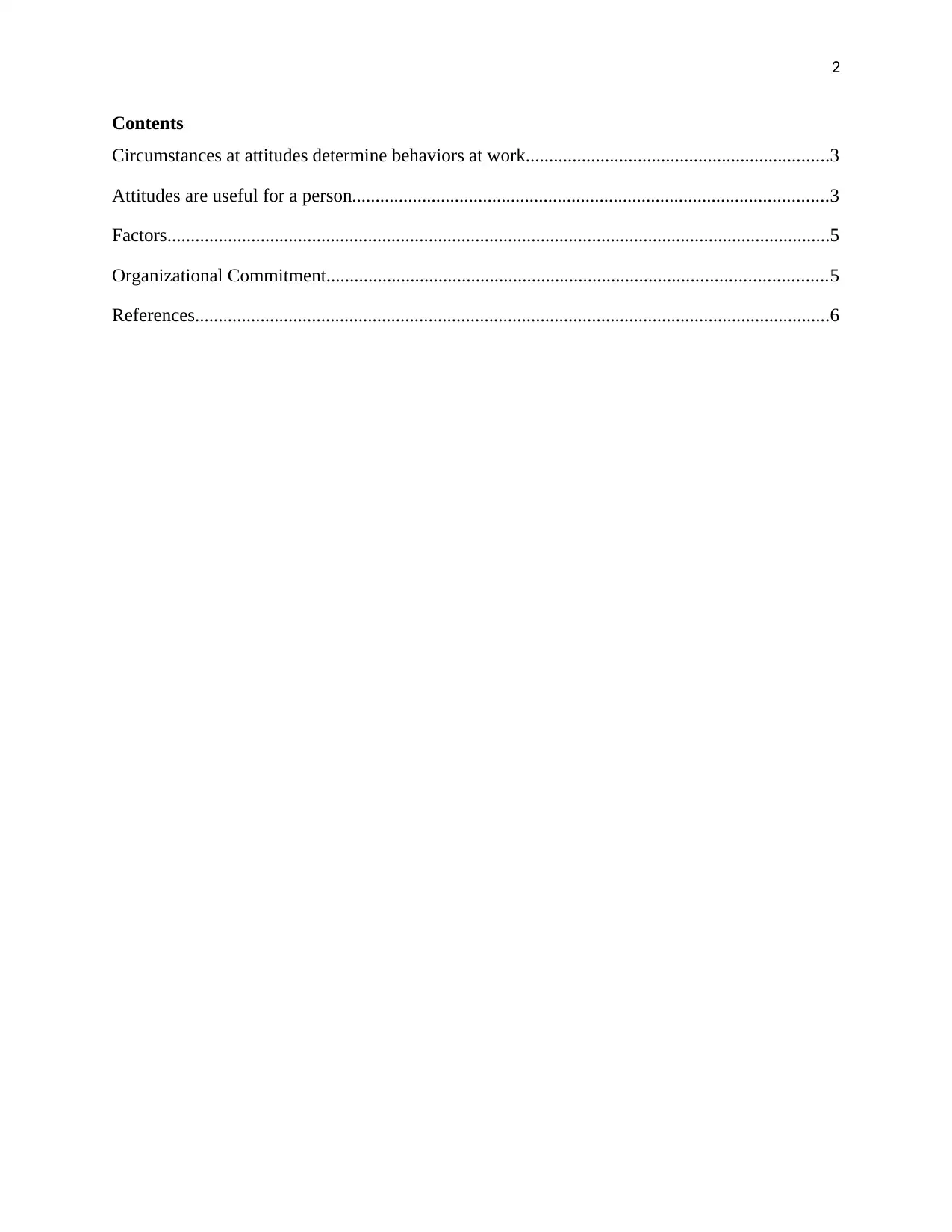
2
Contents
Circumstances at attitudes determine behaviors at work.................................................................3
Attitudes are useful for a person......................................................................................................3
Factors..............................................................................................................................................5
Organizational Commitment...........................................................................................................5
References........................................................................................................................................6
Contents
Circumstances at attitudes determine behaviors at work.................................................................3
Attitudes are useful for a person......................................................................................................3
Factors..............................................................................................................................................5
Organizational Commitment...........................................................................................................5
References........................................................................................................................................6
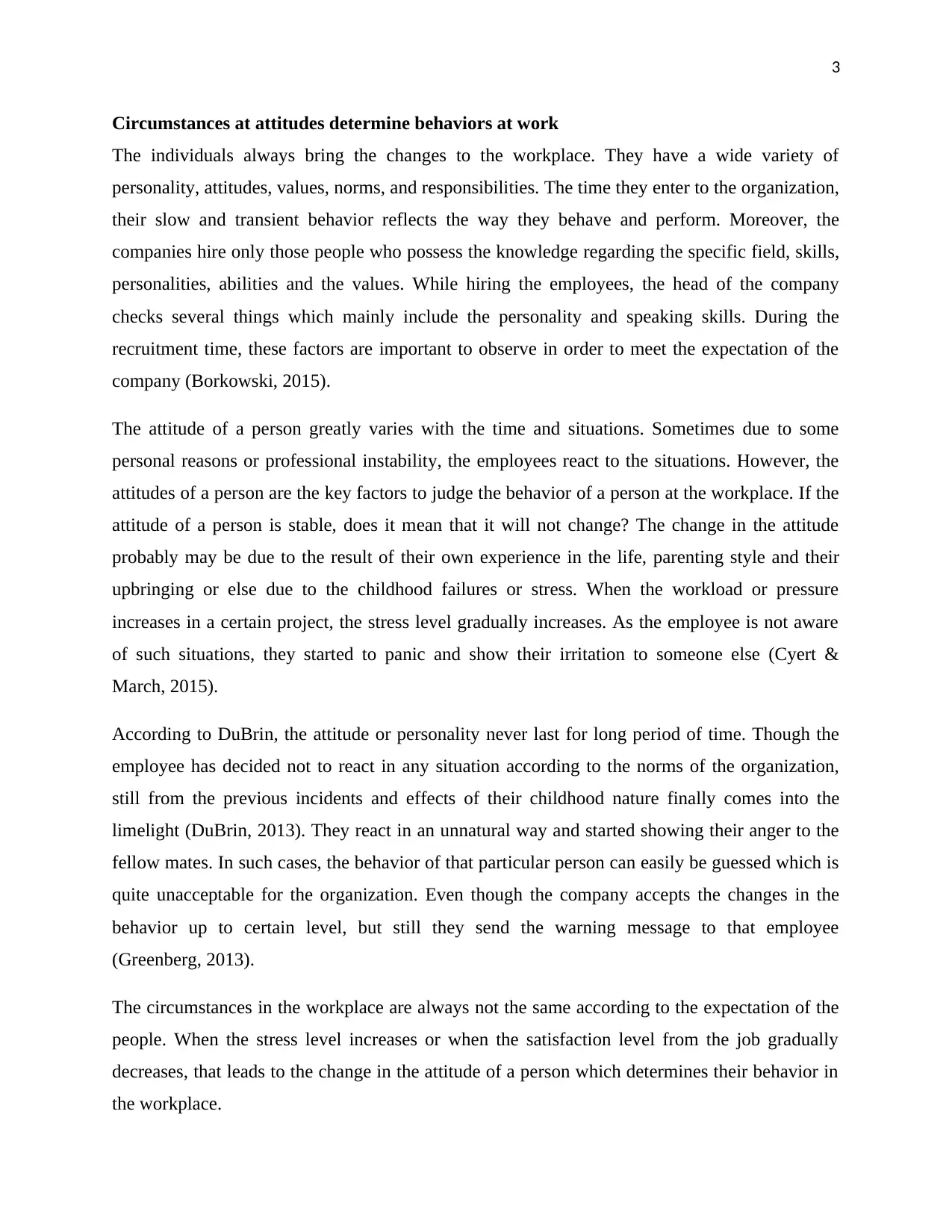
3
Circumstances at attitudes determine behaviors at work
The individuals always bring the changes to the workplace. They have a wide variety of
personality, attitudes, values, norms, and responsibilities. The time they enter to the organization,
their slow and transient behavior reflects the way they behave and perform. Moreover, the
companies hire only those people who possess the knowledge regarding the specific field, skills,
personalities, abilities and the values. While hiring the employees, the head of the company
checks several things which mainly include the personality and speaking skills. During the
recruitment time, these factors are important to observe in order to meet the expectation of the
company (Borkowski, 2015).
The attitude of a person greatly varies with the time and situations. Sometimes due to some
personal reasons or professional instability, the employees react to the situations. However, the
attitudes of a person are the key factors to judge the behavior of a person at the workplace. If the
attitude of a person is stable, does it mean that it will not change? The change in the attitude
probably may be due to the result of their own experience in the life, parenting style and their
upbringing or else due to the childhood failures or stress. When the workload or pressure
increases in a certain project, the stress level gradually increases. As the employee is not aware
of such situations, they started to panic and show their irritation to someone else (Cyert &
March, 2015).
According to DuBrin, the attitude or personality never last for long period of time. Though the
employee has decided not to react in any situation according to the norms of the organization,
still from the previous incidents and effects of their childhood nature finally comes into the
limelight (DuBrin, 2013). They react in an unnatural way and started showing their anger to the
fellow mates. In such cases, the behavior of that particular person can easily be guessed which is
quite unacceptable for the organization. Even though the company accepts the changes in the
behavior up to certain level, but still they send the warning message to that employee
(Greenberg, 2013).
The circumstances in the workplace are always not the same according to the expectation of the
people. When the stress level increases or when the satisfaction level from the job gradually
decreases, that leads to the change in the attitude of a person which determines their behavior in
the workplace.
Circumstances at attitudes determine behaviors at work
The individuals always bring the changes to the workplace. They have a wide variety of
personality, attitudes, values, norms, and responsibilities. The time they enter to the organization,
their slow and transient behavior reflects the way they behave and perform. Moreover, the
companies hire only those people who possess the knowledge regarding the specific field, skills,
personalities, abilities and the values. While hiring the employees, the head of the company
checks several things which mainly include the personality and speaking skills. During the
recruitment time, these factors are important to observe in order to meet the expectation of the
company (Borkowski, 2015).
The attitude of a person greatly varies with the time and situations. Sometimes due to some
personal reasons or professional instability, the employees react to the situations. However, the
attitudes of a person are the key factors to judge the behavior of a person at the workplace. If the
attitude of a person is stable, does it mean that it will not change? The change in the attitude
probably may be due to the result of their own experience in the life, parenting style and their
upbringing or else due to the childhood failures or stress. When the workload or pressure
increases in a certain project, the stress level gradually increases. As the employee is not aware
of such situations, they started to panic and show their irritation to someone else (Cyert &
March, 2015).
According to DuBrin, the attitude or personality never last for long period of time. Though the
employee has decided not to react in any situation according to the norms of the organization,
still from the previous incidents and effects of their childhood nature finally comes into the
limelight (DuBrin, 2013). They react in an unnatural way and started showing their anger to the
fellow mates. In such cases, the behavior of that particular person can easily be guessed which is
quite unacceptable for the organization. Even though the company accepts the changes in the
behavior up to certain level, but still they send the warning message to that employee
(Greenberg, 2013).
The circumstances in the workplace are always not the same according to the expectation of the
people. When the stress level increases or when the satisfaction level from the job gradually
decreases, that leads to the change in the attitude of a person which determines their behavior in
the workplace.
⊘ This is a preview!⊘
Do you want full access?
Subscribe today to unlock all pages.

Trusted by 1+ million students worldwide
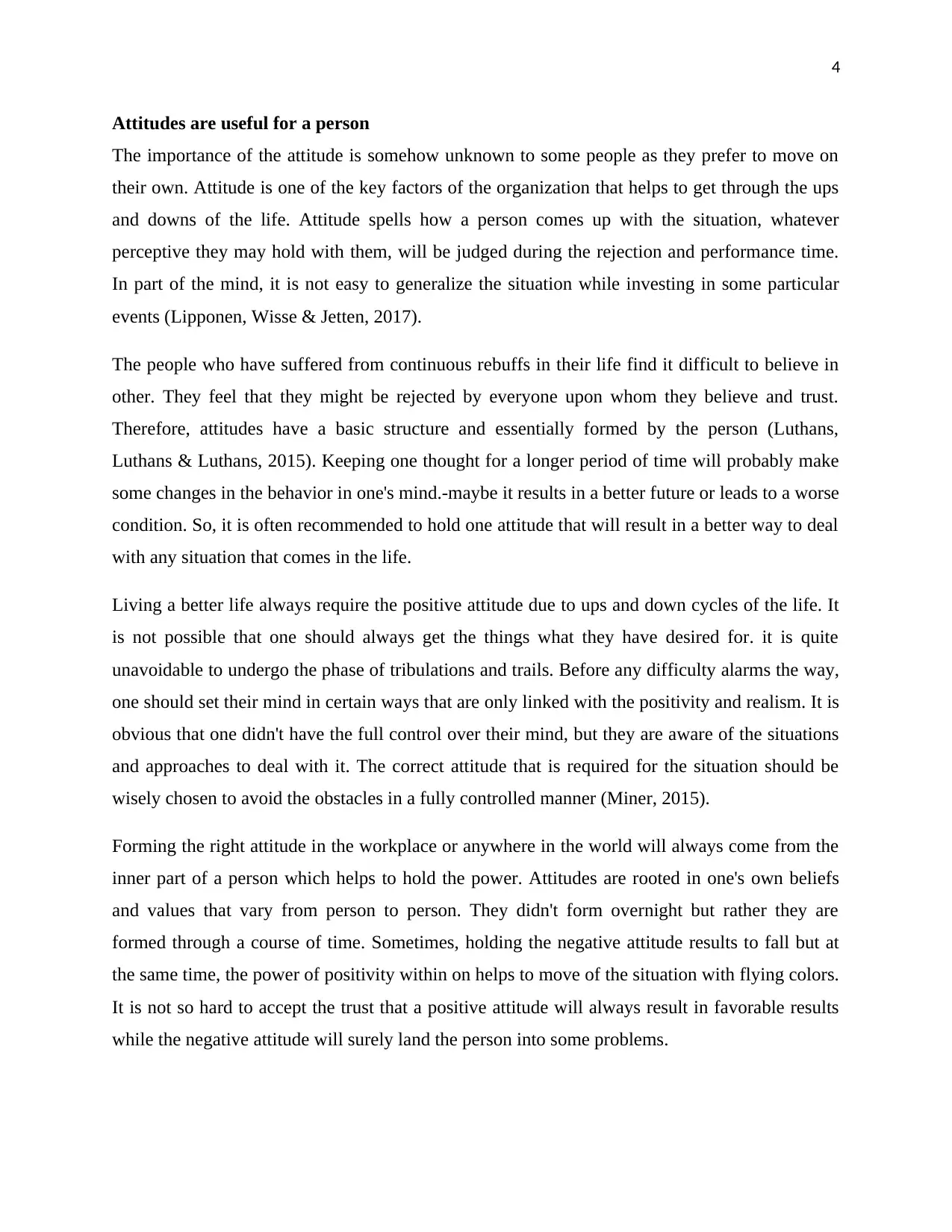
4
Attitudes are useful for a person
The importance of the attitude is somehow unknown to some people as they prefer to move on
their own. Attitude is one of the key factors of the organization that helps to get through the ups
and downs of the life. Attitude spells how a person comes up with the situation, whatever
perceptive they may hold with them, will be judged during the rejection and performance time.
In part of the mind, it is not easy to generalize the situation while investing in some particular
events (Lipponen, Wisse & Jetten, 2017).
The people who have suffered from continuous rebuffs in their life find it difficult to believe in
other. They feel that they might be rejected by everyone upon whom they believe and trust.
Therefore, attitudes have a basic structure and essentially formed by the person (Luthans,
Luthans & Luthans, 2015). Keeping one thought for a longer period of time will probably make
some changes in the behavior in one's mind.-maybe it results in a better future or leads to a worse
condition. So, it is often recommended to hold one attitude that will result in a better way to deal
with any situation that comes in the life.
Living a better life always require the positive attitude due to ups and down cycles of the life. It
is not possible that one should always get the things what they have desired for. it is quite
unavoidable to undergo the phase of tribulations and trails. Before any difficulty alarms the way,
one should set their mind in certain ways that are only linked with the positivity and realism. It is
obvious that one didn't have the full control over their mind, but they are aware of the situations
and approaches to deal with it. The correct attitude that is required for the situation should be
wisely chosen to avoid the obstacles in a fully controlled manner (Miner, 2015).
Forming the right attitude in the workplace or anywhere in the world will always come from the
inner part of a person which helps to hold the power. Attitudes are rooted in one's own beliefs
and values that vary from person to person. They didn't form overnight but rather they are
formed through a course of time. Sometimes, holding the negative attitude results to fall but at
the same time, the power of positivity within on helps to move of the situation with flying colors.
It is not so hard to accept the trust that a positive attitude will always result in favorable results
while the negative attitude will surely land the person into some problems.
Attitudes are useful for a person
The importance of the attitude is somehow unknown to some people as they prefer to move on
their own. Attitude is one of the key factors of the organization that helps to get through the ups
and downs of the life. Attitude spells how a person comes up with the situation, whatever
perceptive they may hold with them, will be judged during the rejection and performance time.
In part of the mind, it is not easy to generalize the situation while investing in some particular
events (Lipponen, Wisse & Jetten, 2017).
The people who have suffered from continuous rebuffs in their life find it difficult to believe in
other. They feel that they might be rejected by everyone upon whom they believe and trust.
Therefore, attitudes have a basic structure and essentially formed by the person (Luthans,
Luthans & Luthans, 2015). Keeping one thought for a longer period of time will probably make
some changes in the behavior in one's mind.-maybe it results in a better future or leads to a worse
condition. So, it is often recommended to hold one attitude that will result in a better way to deal
with any situation that comes in the life.
Living a better life always require the positive attitude due to ups and down cycles of the life. It
is not possible that one should always get the things what they have desired for. it is quite
unavoidable to undergo the phase of tribulations and trails. Before any difficulty alarms the way,
one should set their mind in certain ways that are only linked with the positivity and realism. It is
obvious that one didn't have the full control over their mind, but they are aware of the situations
and approaches to deal with it. The correct attitude that is required for the situation should be
wisely chosen to avoid the obstacles in a fully controlled manner (Miner, 2015).
Forming the right attitude in the workplace or anywhere in the world will always come from the
inner part of a person which helps to hold the power. Attitudes are rooted in one's own beliefs
and values that vary from person to person. They didn't form overnight but rather they are
formed through a course of time. Sometimes, holding the negative attitude results to fall but at
the same time, the power of positivity within on helps to move of the situation with flying colors.
It is not so hard to accept the trust that a positive attitude will always result in favorable results
while the negative attitude will surely land the person into some problems.
Paraphrase This Document
Need a fresh take? Get an instant paraphrase of this document with our AI Paraphraser
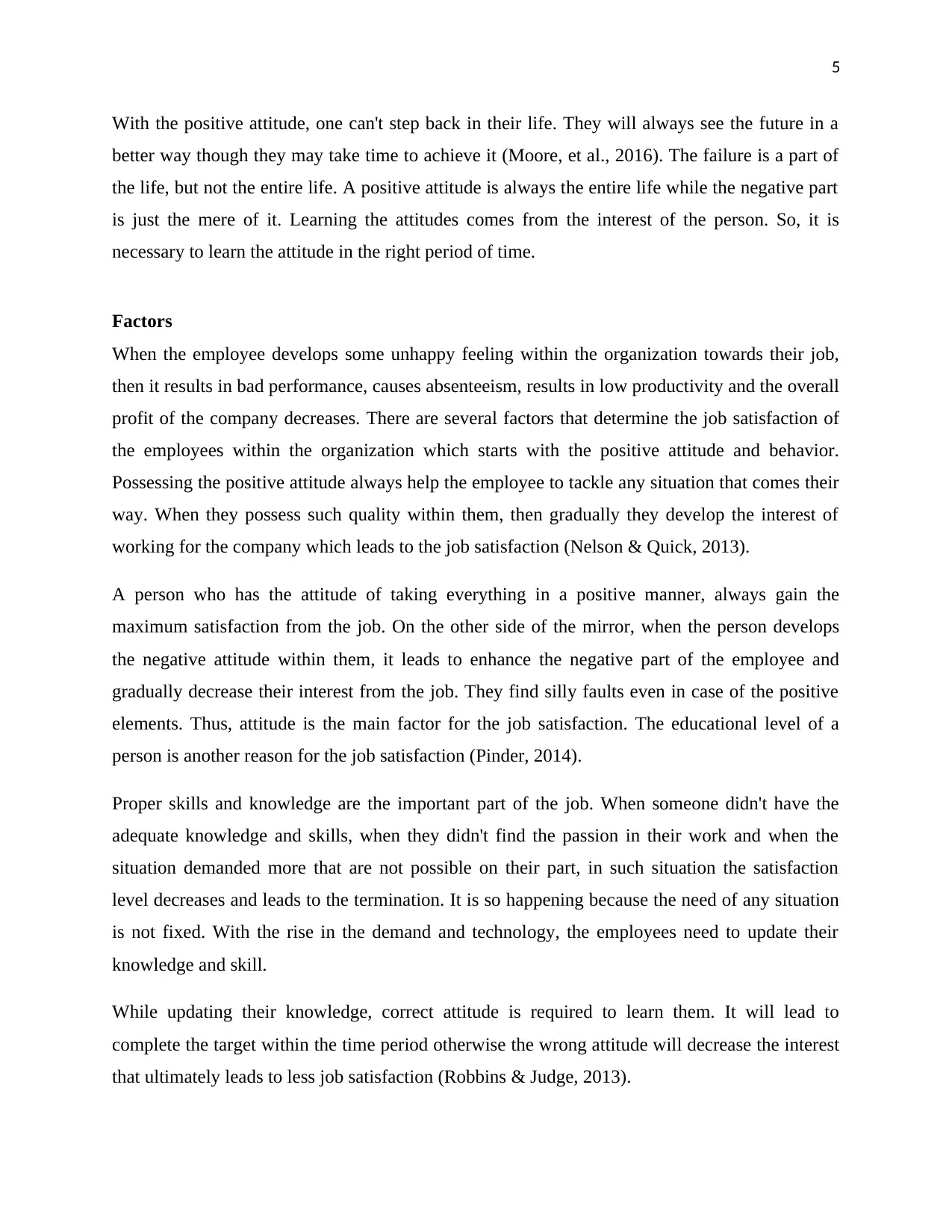
5
With the positive attitude, one can't step back in their life. They will always see the future in a
better way though they may take time to achieve it (Moore, et al., 2016). The failure is a part of
the life, but not the entire life. A positive attitude is always the entire life while the negative part
is just the mere of it. Learning the attitudes comes from the interest of the person. So, it is
necessary to learn the attitude in the right period of time.
Factors
When the employee develops some unhappy feeling within the organization towards their job,
then it results in bad performance, causes absenteeism, results in low productivity and the overall
profit of the company decreases. There are several factors that determine the job satisfaction of
the employees within the organization which starts with the positive attitude and behavior.
Possessing the positive attitude always help the employee to tackle any situation that comes their
way. When they possess such quality within them, then gradually they develop the interest of
working for the company which leads to the job satisfaction (Nelson & Quick, 2013).
A person who has the attitude of taking everything in a positive manner, always gain the
maximum satisfaction from the job. On the other side of the mirror, when the person develops
the negative attitude within them, it leads to enhance the negative part of the employee and
gradually decrease their interest from the job. They find silly faults even in case of the positive
elements. Thus, attitude is the main factor for the job satisfaction. The educational level of a
person is another reason for the job satisfaction (Pinder, 2014).
Proper skills and knowledge are the important part of the job. When someone didn't have the
adequate knowledge and skills, when they didn't find the passion in their work and when the
situation demanded more that are not possible on their part, in such situation the satisfaction
level decreases and leads to the termination. It is so happening because the need of any situation
is not fixed. With the rise in the demand and technology, the employees need to update their
knowledge and skill.
While updating their knowledge, correct attitude is required to learn them. It will lead to
complete the target within the time period otherwise the wrong attitude will decrease the interest
that ultimately leads to less job satisfaction (Robbins & Judge, 2013).
With the positive attitude, one can't step back in their life. They will always see the future in a
better way though they may take time to achieve it (Moore, et al., 2016). The failure is a part of
the life, but not the entire life. A positive attitude is always the entire life while the negative part
is just the mere of it. Learning the attitudes comes from the interest of the person. So, it is
necessary to learn the attitude in the right period of time.
Factors
When the employee develops some unhappy feeling within the organization towards their job,
then it results in bad performance, causes absenteeism, results in low productivity and the overall
profit of the company decreases. There are several factors that determine the job satisfaction of
the employees within the organization which starts with the positive attitude and behavior.
Possessing the positive attitude always help the employee to tackle any situation that comes their
way. When they possess such quality within them, then gradually they develop the interest of
working for the company which leads to the job satisfaction (Nelson & Quick, 2013).
A person who has the attitude of taking everything in a positive manner, always gain the
maximum satisfaction from the job. On the other side of the mirror, when the person develops
the negative attitude within them, it leads to enhance the negative part of the employee and
gradually decrease their interest from the job. They find silly faults even in case of the positive
elements. Thus, attitude is the main factor for the job satisfaction. The educational level of a
person is another reason for the job satisfaction (Pinder, 2014).
Proper skills and knowledge are the important part of the job. When someone didn't have the
adequate knowledge and skills, when they didn't find the passion in their work and when the
situation demanded more that are not possible on their part, in such situation the satisfaction
level decreases and leads to the termination. It is so happening because the need of any situation
is not fixed. With the rise in the demand and technology, the employees need to update their
knowledge and skill.
While updating their knowledge, correct attitude is required to learn them. It will lead to
complete the target within the time period otherwise the wrong attitude will decrease the interest
that ultimately leads to less job satisfaction (Robbins & Judge, 2013).
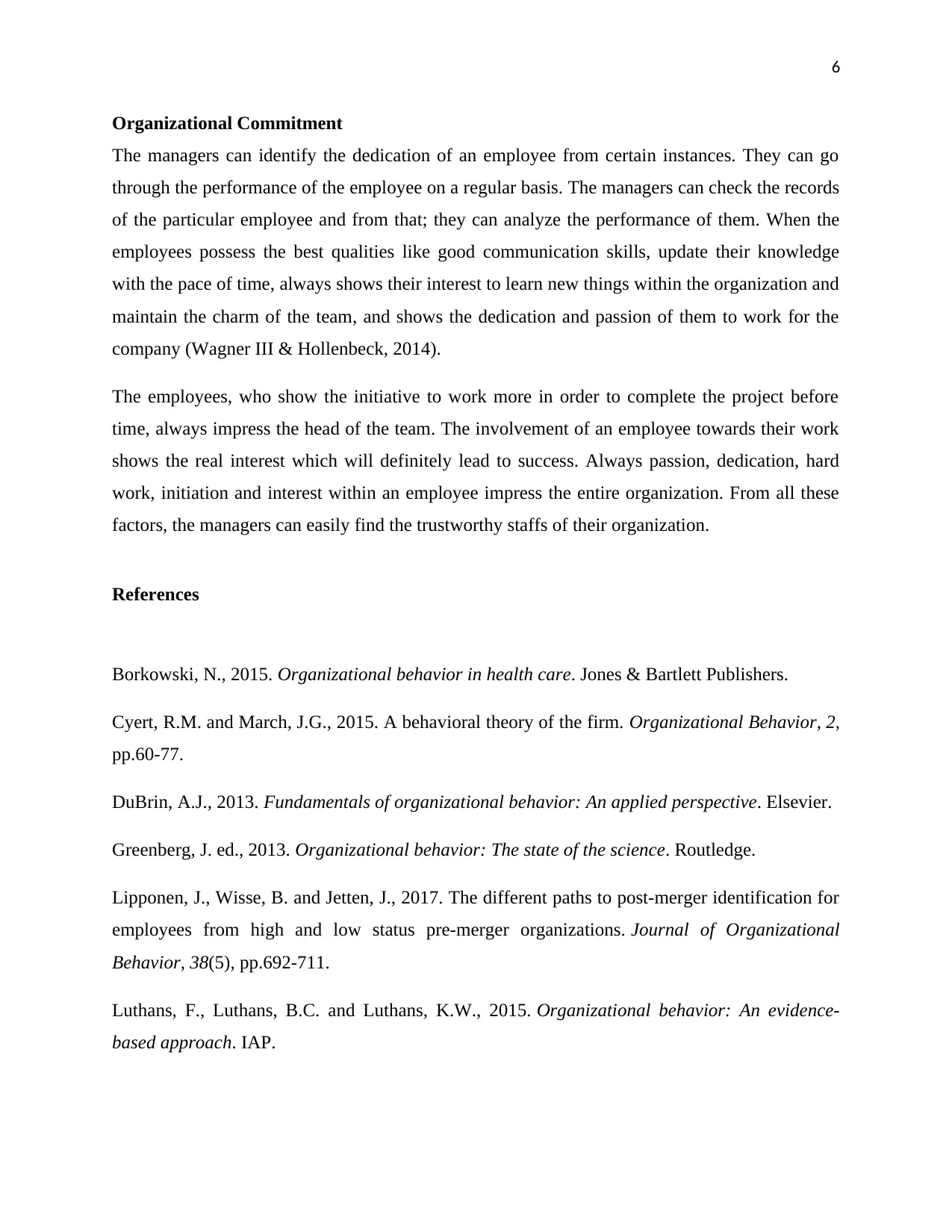
6
Organizational Commitment
The managers can identify the dedication of an employee from certain instances. They can go
through the performance of the employee on a regular basis. The managers can check the records
of the particular employee and from that; they can analyze the performance of them. When the
employees possess the best qualities like good communication skills, update their knowledge
with the pace of time, always shows their interest to learn new things within the organization and
maintain the charm of the team, and shows the dedication and passion of them to work for the
company (Wagner III & Hollenbeck, 2014).
The employees, who show the initiative to work more in order to complete the project before
time, always impress the head of the team. The involvement of an employee towards their work
shows the real interest which will definitely lead to success. Always passion, dedication, hard
work, initiation and interest within an employee impress the entire organization. From all these
factors, the managers can easily find the trustworthy staffs of their organization.
References
Borkowski, N., 2015. Organizational behavior in health care. Jones & Bartlett Publishers.
Cyert, R.M. and March, J.G., 2015. A behavioral theory of the firm. Organizational Behavior, 2,
pp.60-77.
DuBrin, A.J., 2013. Fundamentals of organizational behavior: An applied perspective. Elsevier.
Greenberg, J. ed., 2013. Organizational behavior: The state of the science. Routledge.
Lipponen, J., Wisse, B. and Jetten, J., 2017. The different paths to post‐merger identification for
employees from high and low status pre‐merger organizations. Journal of Organizational
Behavior, 38(5), pp.692-711.
Luthans, F., Luthans, B.C. and Luthans, K.W., 2015. Organizational behavior: An evidence-
based approach. IAP.
Organizational Commitment
The managers can identify the dedication of an employee from certain instances. They can go
through the performance of the employee on a regular basis. The managers can check the records
of the particular employee and from that; they can analyze the performance of them. When the
employees possess the best qualities like good communication skills, update their knowledge
with the pace of time, always shows their interest to learn new things within the organization and
maintain the charm of the team, and shows the dedication and passion of them to work for the
company (Wagner III & Hollenbeck, 2014).
The employees, who show the initiative to work more in order to complete the project before
time, always impress the head of the team. The involvement of an employee towards their work
shows the real interest which will definitely lead to success. Always passion, dedication, hard
work, initiation and interest within an employee impress the entire organization. From all these
factors, the managers can easily find the trustworthy staffs of their organization.
References
Borkowski, N., 2015. Organizational behavior in health care. Jones & Bartlett Publishers.
Cyert, R.M. and March, J.G., 2015. A behavioral theory of the firm. Organizational Behavior, 2,
pp.60-77.
DuBrin, A.J., 2013. Fundamentals of organizational behavior: An applied perspective. Elsevier.
Greenberg, J. ed., 2013. Organizational behavior: The state of the science. Routledge.
Lipponen, J., Wisse, B. and Jetten, J., 2017. The different paths to post‐merger identification for
employees from high and low status pre‐merger organizations. Journal of Organizational
Behavior, 38(5), pp.692-711.
Luthans, F., Luthans, B.C. and Luthans, K.W., 2015. Organizational behavior: An evidence-
based approach. IAP.
⊘ This is a preview!⊘
Do you want full access?
Subscribe today to unlock all pages.

Trusted by 1+ million students worldwide
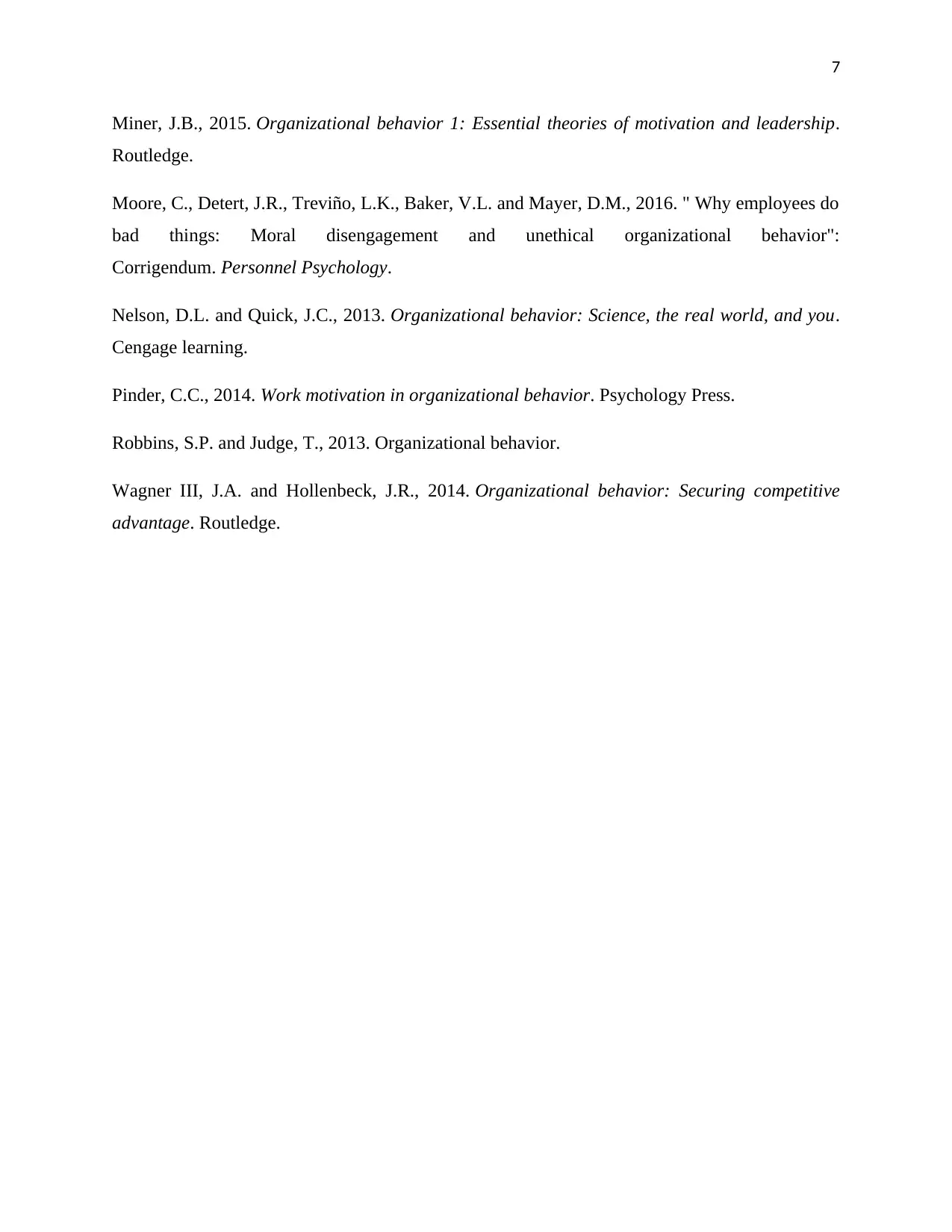
7
Miner, J.B., 2015. Organizational behavior 1: Essential theories of motivation and leadership.
Routledge.
Moore, C., Detert, J.R., Treviño, L.K., Baker, V.L. and Mayer, D.M., 2016. " Why employees do
bad things: Moral disengagement and unethical organizational behavior":
Corrigendum. Personnel Psychology.
Nelson, D.L. and Quick, J.C., 2013. Organizational behavior: Science, the real world, and you.
Cengage learning.
Pinder, C.C., 2014. Work motivation in organizational behavior. Psychology Press.
Robbins, S.P. and Judge, T., 2013. Organizational behavior.
Wagner III, J.A. and Hollenbeck, J.R., 2014. Organizational behavior: Securing competitive
advantage. Routledge.
Miner, J.B., 2015. Organizational behavior 1: Essential theories of motivation and leadership.
Routledge.
Moore, C., Detert, J.R., Treviño, L.K., Baker, V.L. and Mayer, D.M., 2016. " Why employees do
bad things: Moral disengagement and unethical organizational behavior":
Corrigendum. Personnel Psychology.
Nelson, D.L. and Quick, J.C., 2013. Organizational behavior: Science, the real world, and you.
Cengage learning.
Pinder, C.C., 2014. Work motivation in organizational behavior. Psychology Press.
Robbins, S.P. and Judge, T., 2013. Organizational behavior.
Wagner III, J.A. and Hollenbeck, J.R., 2014. Organizational behavior: Securing competitive
advantage. Routledge.
1 out of 7
Related Documents
Your All-in-One AI-Powered Toolkit for Academic Success.
+13062052269
info@desklib.com
Available 24*7 on WhatsApp / Email
![[object Object]](/_next/static/media/star-bottom.7253800d.svg)
Unlock your academic potential
Copyright © 2020–2025 A2Z Services. All Rights Reserved. Developed and managed by ZUCOL.





